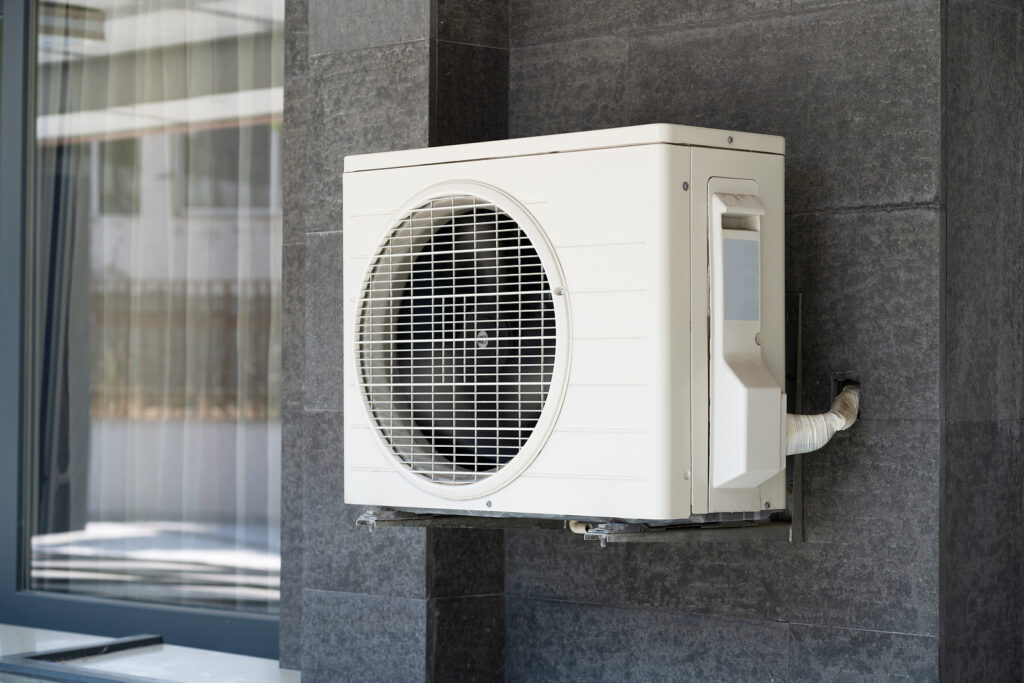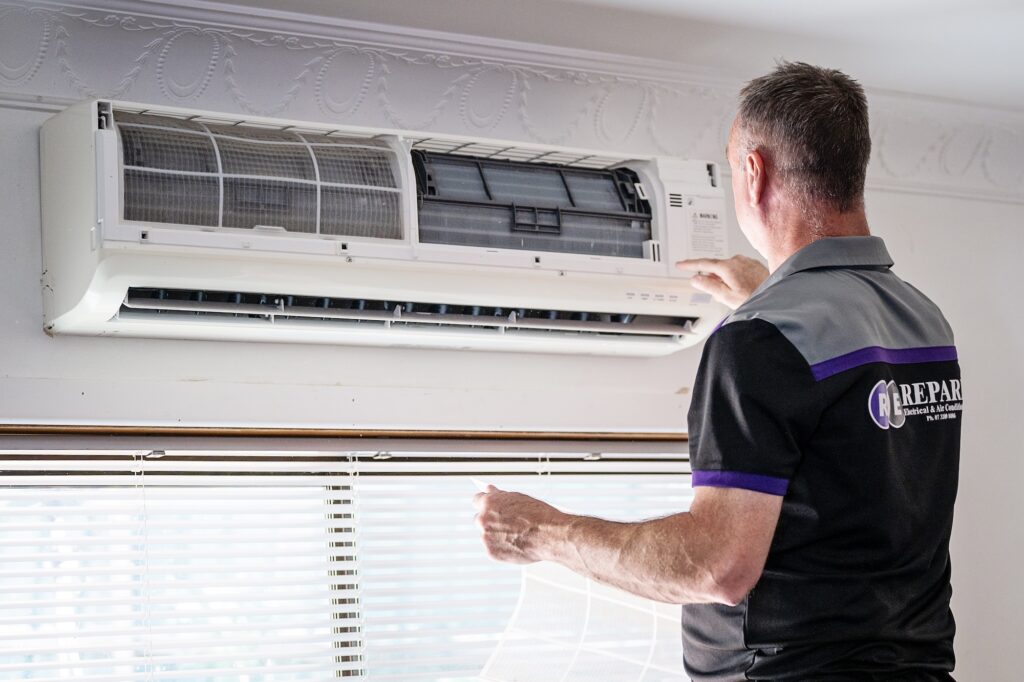Split air conditioning systems are popular for their efficiency and quiet operation.
Whether you’re looking to install a split system or already have one, knowing its key components can help you maintain and get the most out of it.
At REPARE our air conditioning team in Logan is here to guide you through the essentials, offering professional and friendly advice to keep your home comfortable all year round!

AC split system components: what makes your system run smoothly year-round?
1. Outdoor unit (the condenser)
The outdoor unit, often called the condenser, is the part of the split system that sits outside your home. It’s usually placed on a concrete/plastic slab or mounted to an exterior wall.
The outdoor unit is responsible for releasing the heat that’s absorbed from inside during cooling or drawing heat in when the system is heating.
This unit houses key components like the compressor and fan, which work together to manage the refrigerant. This critical piece of the equation helps to ensure your home stays comfortable – whether that’s cooling you down in summer or keeping you warm and cosy in winter!
2. Indoor unit
The indoor unit, often mounted high on a wall, is the part you see inside your home. This unit is responsible for blowing cool or warm air into the room. (This depends on whether the system is set to cooling or heating.)
Inside, it houses the evaporator coil, which helps absorb heat when cooling, or release heat when warming. It’s quiet and efficient, working in the background to keep your space at the perfect temperature.
3. Refrigerant
Refrigerant is like the lifeblood of your split system!
It is constantly moving between the indoor and outdoor units. It absorbs heat from inside your home during cooling mode and releases it outside. (This works in reverse during heating).
While you won’t see it, the refrigerant plays a key role in transferring heat, allowing your system to heat or cool your space effectively. It’s important to have the right amount of refrigerant, so regular maintenance is key to keeping everything running smoothly.
Curious to learn how this compares to ducted? Explore how ducted air conditioning works here.
4. Compressor
The compressor, located in the outdoor unit, acts as the heart of the system.
It pumps the refrigerant between the indoor and outdoor units, compressing it to a higher pressure, allowing it to release or absorb heat efficiently.
In simpler terms, the compressor powers the heating and cooling process, ensuring your home stays at the right temperature, no matter the season. If the compressor isn’t functioning properly, your system won’t be able to cool or heat effectively.
5. Expansion valve
The expansion valve might be a small part of the system, but it plays a significant role in controlling the refrigerant flow. It’s responsible for reducing the pressure of the refrigerant before it enters the indoor unit.
This pressure drop allows the refrigerant to absorb heat more effectively when cooling (or release it when heating.) Think of it as the gatekeeper that ensures the right amount of refrigerant is used to keep your space comfortable all year round.
6. Thermostat
The thermostat is your control centre for the split system. It allows you to set your desired temperature for both heating and cooling, ensuring your home stays comfortable.
Modern systems often come with smart thermostats, giving you more control with features like scheduling and remote operation via your smartphone.
It’s not just about comfort though. A well-set thermostat can also help you manage energy use efficiently, keeping your power bills in check!
7. Piping and wiring
Piping and wiring may not be visible, but they’re essential to your split system’s operation.
The pipes carry the refrigerant between the indoor and outdoor units, while the wiring connects all the components and ensures they communicate properly.
These hidden elements allow the system to function smoothly, ensuring that both heating and cooling are delivered efficiently to keep your home at the perfect temperature. Proper installation and maintenance of the piping and wiring are key to avoiding potential breakdowns or energy loss.
8. Filters
The filters in your split system are crucial in maintaining air quality and system performance.
They trap dust, allergens, and other particles, ensuring the air you breathe is clean and fresh, whether you’re heating or cooling.
Over time, these filters can get clogged, which can reduce the efficiency of the system and affect the air quality in your home. Regular cleaning or replacement of the filters is essential to keep your system running smoothly and your air clean.

Split system FAQs
Can a split system be used for both heating and cooling?
Yes, split systems can be used for both heating and cooling, thanks to reverse cycle technology. This technology allows the system to reverse the refrigeration process, drawing heat from outside to warm your home or releasing it to cool.
While split systems are ideal for individual rooms, ducted systems might be a better solution for whole-home heating and cooling. If you’re weighing up your options, check out our detailed comparison of ducted vs. split air conditioning systems to help you decide which one suits your needs best.
How often should I clean or replace my split system’s filters?
It’s recommended to clean or replace your filters every 3 to 6 months, depending on how often the system is used and the air quality in your home. A good rule of thumb is to check and clean them at the start of winter and summer, when the system sees the most use.
Regular cleaning ensures the system operates efficiently and maintains good air quality.
What size split system do I need for my home?
The size of the split system depends on the room’s size and insulation. As a general guide, a 2.5 kW system is suitable for a small room, while larger living spaces may need up to 9 kW. REPARE’s air con experts can help you choose the right size for your needs.
Choosing the right size system for your space is essential to enjoy the cost savings associated with split systems. For a more detailed breakdown of the running costs between ducted and split, explore this article.
While split systems are great for individual rooms, ducted systems might be a better option if you’re looking to heat or cool multiple areas at once. Curious about sizing for ducted systems? Learn more about ducted air con sizing here.
How energy efficient are split systems?
Yes! Split systems are an effective and efficient heating and cooling solution, particularly for smaller homes or spaces where you require individual control in different rooms.
They allow for precise temperature control and adjust power usage based on the room’s needs, helping to lower energy consumption compared to other heating and cooling systems.
Can I install a split system myself?
No, installing a split system should be done by a licensed professional. Improper installation can lead to inefficiency, potential damage, or safety hazards. A certified installer ensures the system runs efficiently and meets Australian standards.
Are split systems noisy?
Modern split systems are designed to be very quiet, especially the indoor unit. Noise levels vary depending on the brand and model, but most systems run with minimal noise, allowing for a comfortable environment without disturbance.
Get the best performance from your split system all year round!
Split air conditioning systems are a reliable and efficient choice for year-round comfort. Understanding the main components and their functions will help you to better maintain and get the most out of your system.
For professional installation or maintenance, REPARE’s experienced team is here to help with friendly, expert service!
Give us a call today on (07) 3209 8006 or get in touch online and we’ll get back to you soon!